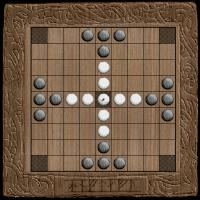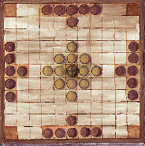Tafl game

Hnefa-Tafl.
A Tafl game is a type of board game in which the contest is between two forces of unequal number or strength. The earliest form Tafl (old Norse for "table") game, known as Hnefa-Tafl ("King's Table") originated in Scandinavia before AD 400 and was then exported by the Vikings to Greenland, Iceland (where it is mentioned in the Grettis Saga dating back to AD 1300), Ireland, England, Wales and as far east as the Ukraine. Several boards unearthed in both Viking and Anglo-Saxon contexts, including the board found at the Gokstad ship burial, have had Hnefa-Tafl on one side and Nine Men's Morris on the other.
Other and later variants of Tafl include Tabula (the medieval ancestor of backgammon, introduced from the French as Quatre and thus Kvatru-Tafl), Fox and Geese (Ref-Skak, "Fox Chess", Hala-Tafl or Freys-Tafl), Three Men's Morris (Hrae-Tafl, "Quick-Tafl"), and Nine Men's Morris.
 |
Hnefa-Tafl
Hnefa-Tafl is the Viking equivalent of chess and a particular form of a Tafl
game. It effectively models the kind of internal conflict familiar to
the Vikings and recounted in the best known of the Icelandic sagas: Njal's
Saga. The king or chieftain sits in his hall, surrounded by his thanes.
His enemies gather in secret, and in numbers sufficient to overwhelm the
king's standing forces in a lightning raid. They gather around the king's
hall and set it alight, forcing the defenders to fight in the open or burn
in the hall. If the king can, by some desperate stratagem, break free and
escape the trap, he can rally his people and strike back at his enemies.
If not, he dies. Hnefa-Tafl reflects this mode of contest. The board measures
19 × 19 grid lines (though sometimes as small as 7 × 7), and the
pieces are placed at the points of the intersections (curiously analogous
to the oriental game of go, which also uses 19 × 19 lines and where
play occurs at the intersections.) The opposing forces are unequal in size,
and have different objectives: the attackers attempt to trap the king in
his hall, while the defenders try to open an escape route for him.
Fitchneal is an Irish version of Hnefa-Tafl. It is played on a 7 × 7 board (as was the Scottish equivalent, known as Ard-Ri, "High King") and it is mentioned in the Mabinogion and Cormac's Glossary of the 9th century.


